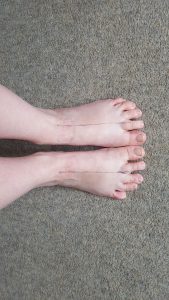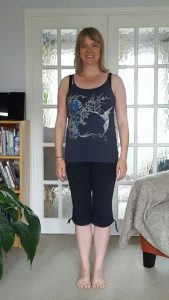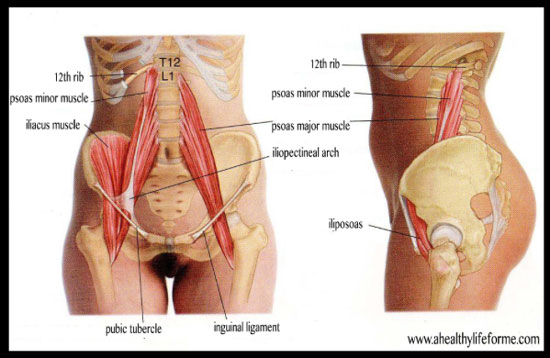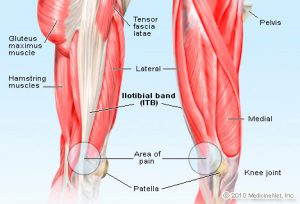 Our bodies and our minds are intimately connected and how we use our bodies has an impact – positive or negative – on our mind. If we are suffering from anxiety, depression or symptoms of trauma such as numbness or dissociation, practising standing postures can help to ground us and bring us into our bodies in a way that is beneficial to the mind.
Our bodies and our minds are intimately connected and how we use our bodies has an impact – positive or negative – on our mind. If we are suffering from anxiety, depression or symptoms of trauma such as numbness or dissociation, practising standing postures can help to ground us and bring us into our bodies in a way that is beneficial to the mind.
For example, think about how you stand automatically. You may notice that your feet are all over the place. By simply bringing your feet together, in a mindful way, helps your feet know where ‘home’ is.
But to bring them completely together is quite difficult. We often stand with our feet quite wide apart. I am an experienced yoga practitioner and teacher, and in the last year or so, I have started to practise yoga standing postures with my feet together and the effect on both body and mind has been quite amazing.
What does ‘feet together’ really mean?
Whilst it can mean big toes and heel bone touching, a better alignment is when the feet are parallel and touching. And for this to happen the big toes come together and the heels are a little apart (see pic). If you draw a line on your feet from the mid point of your ankle to the radial edge of your second toe, those two lines should be parallel.
Watch this video to see this in action:
LINK TO VIDEO –
When I do my yoga practice in or from this position across a range of postures such as those shown below, I have found two major benefits: one is in the energetic nature of the pose and the other is in my connection to core.
Containment of energy
 In order to stand in this ‘feet together’ position, I focus on pushing into the balls of my big toes, the shins rotate radially outwards a little and the inner thighs draw upwards and inwards (medial rotation). This pushes the seat bones out and gives space in the sacral joint, back of the hips and keeps the pelvis upright and neutral (which lengthens the psoas muscle) and thus honours the natural curvature of the spine. There seems to be more containment and control of energy – perhaps this is because the muscles used to hold this posture activate the bandhas (root locks) particularly mula bandha. This feels like l have more control over my energy, I feel calmer and more centred and in control.
In order to stand in this ‘feet together’ position, I focus on pushing into the balls of my big toes, the shins rotate radially outwards a little and the inner thighs draw upwards and inwards (medial rotation). This pushes the seat bones out and gives space in the sacral joint, back of the hips and keeps the pelvis upright and neutral (which lengthens the psoas muscle) and thus honours the natural curvature of the spine. There seems to be more containment and control of energy – perhaps this is because the muscles used to hold this posture activate the bandhas (root locks) particularly mula bandha. This feels like l have more control over my energy, I feel calmer and more centred and in control.
It also helps me to feel significantly more focused – my mind has a more single minded concentration. My senses are withdrawn from external distractions to internal awareness (pratyahara) and I am more able to access the state of ‘flow’ (peak performance), a sense of heightened alertness but deeply relaxed simultaneously.Also moving into the postures from that feet together position is a neater, more ‘contained’ movement. It feels like energy is being conserved and there is less waste of energy. Connection to my coreBy working with the feet parallel and together like this, I feel a much stronger connection to my core. This feels like the difference between an elastic band that is taught ready for powerful action and one that has lost its elasticity. The core muscles that I feel involved here are not just the abdominals, but the pelvic floor muscles, the erector spinae (sacrospinalis) especially the longissimus thoracis in the back, and the diaphragm.
In addition, the latissimus dorsi, and the gluteus maximus (the butt muscle) are involved, and also the wonderful psoas muscle – the main muscle of walking – which is connected to the diaphragm and runs onto the thigh bone. In fact the psoas and the diaphragm working together are the two titans of our walking posture. Standing like this, the psoas feels long and free, and in fact it is said that a psoas that is free of tension allows us to connect to the present moment.
This sense of ‘core’ gives me a feeling of being pulled towards my centre and having access to a powerhouse of internal energy. I feel like one strong connected unit, operating from centre, and more able to hold strong poses with less effort. And, I suppose, more able to take life on.
The Benefits
Here are the benefits I have found and researched of doing these poses with the feet ‘together’ (as described fully above) instead of apart:
- it increases muscular engagement with the inner thigh and therefore connects to the core better
- it helps with stabilisation (squeezing action of the inner thighs)
- the joints are properly stacked and the body is in good alignment – 90 degree angle of feet to floor, floor to ankles, ankles to shins
- there is less negative force on the sacroiliac joint
- it improves balance and reduces left/right imbalance
- it engages the bandhas (root lock)
Because the psoas muscle is engaged with the diaphragm, our psoas is flexible and lengthened in this feet together posture, which helps to connect with diaphragm for optimal breathing (starts deeper and lower but feels us into the hips and chest/head), or power breathing, helping with ‘flow’ state of peak performance, with far less anxiety
What goes wrong?
Or what will prevent you being able to work with the feet togetherNot everyone may be functionally able to bring their feet together; this may be due to wide hips, bone structure etc. Therefore in your practice it is vitally important to listen to your body and not do something that will cause pain or discomfort. The main barriers and contraindications to working with the feet together, and doing it carefully and slowly, are:Tight hamstrings and hip flexorsThe hamstrings are three muscles in the back of the thigh that attach at the seat bones and end on the tibia – so effectively they run from the pelvis to below the knee. Tight hamstrings will significantly restrict forward movement and mean that we can more easily damage our spine, because the back overcompensates for the lack of flexibility in these key muscles.
Another muscle group that is often overlooked in such issues are the group of deep hip flexors. They are deep inside the hip, under more famous butt muscle, the gluteous maximus. They all attach to the inside of the inside of the greater trochanter which is the bulb at the top of your thigh bone that goes into the the hip socket. They fan out to different locations around the low pelvis. Please see the image left. They include: piriformis, and the gemellus. Because the deep six are under the gluteus maximus, typically one of the strongest muscles in your body, they are often overshadowed by it. If these are tight they can also restrict flexibility and cause back injuries.

But also bear in mind that the psoas muscle is intimately linked to our psychological wellbeing – a tight psoas will manifest in fear and anxiety, this is because of the psoas connection with the diaphragm and lower brainstem. Practising optimal breathing using the diaphragm will help to lengthen the psoas, which in combination, will thus help to reduce anxiety. In my experience, only around 5 per cent of the population are breathing optimally and this is inextricably linked with anxiety states.
Tightness in the iliotibial band
 Tightness in this muscle is an underlying cause of back injury. The iliotibial band (IT) is a band of fascia that runs down the outside of the legs from the hips to the top of the shins. Remember, fascia is ‘plastic’ and not elastic like muscle, so is hard to change it. The tensor fascia latta (TFL) is the muscle that runs into this band, and this whole structure is often tight, which also causes very tight gluteal muscles. A tight TFL and IT band will pull the knees to the outside of the hips and put undue pressure on the sacrum. It will result in knee, back and sacroiliac problems. Therefore the TFL and IT band need to be stretched and lengthened over time. In my experience, these are some of the most important muscles to befriend in working successfully to access the many benefits of the ‘feet together’ position in yoga. We need to lengthen the hamstrings, the psoas and the often overlooked deep hip flexors as well as the TFL in order to safely work in strong yoga postures from the feet parallel position and also to avoid getting injuries.
Tightness in this muscle is an underlying cause of back injury. The iliotibial band (IT) is a band of fascia that runs down the outside of the legs from the hips to the top of the shins. Remember, fascia is ‘plastic’ and not elastic like muscle, so is hard to change it. The tensor fascia latta (TFL) is the muscle that runs into this band, and this whole structure is often tight, which also causes very tight gluteal muscles. A tight TFL and IT band will pull the knees to the outside of the hips and put undue pressure on the sacrum. It will result in knee, back and sacroiliac problems. Therefore the TFL and IT band need to be stretched and lengthened over time. In my experience, these are some of the most important muscles to befriend in working successfully to access the many benefits of the ‘feet together’ position in yoga. We need to lengthen the hamstrings, the psoas and the often overlooked deep hip flexors as well as the TFL in order to safely work in strong yoga postures from the feet parallel position and also to avoid getting injuries.

